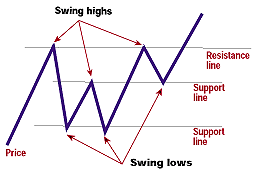Combining Price And Volume To Predict Price Movement
Price + Volume = Price Movement
by Tim Ord
Here's how you can use price and volume to determine buy and sell signals.
I use a lot of different indicators and methods, but one that has been consistently successful is the price/volume relationship at support and resistance levels. Support or resistance areas occur at previous highs and lows. Prices bounce off previous highs and lows and develop trading ranges. I will show you how price and volume react to previous highs and lows, and why price pushes through or reverses at these points.
SWINGS
Previous highs and lows in a stock or index define current support and resistance areas. A previous high or low in a stock or index is referred to as a swing. I draw a horizontal trendline from the previous swing high or low to determine at what price support or resistance will appear in the future. These previous swing highs and lows are points where I make decisions for placing buy or sell orders. The horizontal lines drawn from previous highs and lows indicate where the support or resistance may come in. The line graph of a stock or index in Figure 1 illustrates a swing high and low.
By studying the works of Richard Wyckoff, the master of price and volume, I have developed some rules using the price/volume relationship. Wyckoff developed techniques in the 1930s that combine price and volume of equities with price predictability. The techniques he developed stood the test of time and still work to this day. I expanded on his ideas and came up with several rules that I use daily in my trading. Let's go over these rules and look at a price history to see where buy and sell signals developed.

Figure 1: Swing highs and swing lows. These are created by using the previous highs and lows as reference points.
...Continued in the May issue of Technical Analysis of
STOCKS & COMMODITIES
Excerpted from an article originally published in the May 2004 issue of Technical Analysis of STOCKS & COMMODITIES magazine. All rights reserved. © Copyright 2004, Technical Analysis, Inc.
Return to May 2004 Contents